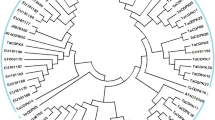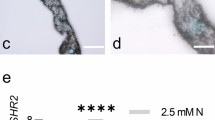Abstract
Background and aims
Jasmonate (JA) and ethylene are involved in the regulation of the aluminum (Al)-induced growth inhibition. Although it has been reported that JA enhances Al-induced root-growth inhibition, its role in the regulation of growth interplaying with ethylene is still not well understood. In this study, we investigated the mechanism underlying the effect of apple MdMYC2 transcription factor on Al stress.
Methods
Overexpression lines were used for functional analysis. Real-time quantitative RT-PCR was used to examine the expression level of ethylene responsive genes. ChIP-PCR, EMSA, and Y1H assays were used to test whether MdMYC2-GST fusion protein could directly bind to MdERF3 promoter. Transient transactivation assays in tobacco leave were conducted to confirm whether MdMYC2 positively regulated the expression of MdERF3.
Results
MdMYC2 negatively regulated Al tolerance with up-regulating the expression of ethylene responsive genes. Moreover, MdMYC2 was observed to bind to the promoter of MdERF3, a positive regulator of ethylene biosynthesis, and directly activated its transcription. And applying the antagonist of ethylene biosynthesis, AVG, alleviated MdMYC2-modulated growth inhibition in Al stress.
Conclusions
We consider that MdMYC2 protein directly interacts and promotes the transcript of MdERF3 to affect ethylene biosynthesis, thereby regulating the Al-mediated stress response. Our findings provide a deeper understanding of the crosstalk between JA and ethylene as well as JA-mediated growth inhibition in apple.








Similar content being viewed by others
Abbreviations
- Al:
-
Aluminum
- ABA:
-
Abscisic acid
- JA:
-
Jasmonate
- SA:
-
Salicylic acid
- ACSs:
-
ACC synthases
- ACOs:
-
ACC oxidases
- COI 1:
-
CORONATINE INSENSITIVE 1
- PIN2:
-
PIN-FORMED 2
- EIN3:
-
ETHYLENE INSENSITIVE 3
- MS:
-
Murashige and Skoog
- IAA:
-
Indole-3-acetic acid
- 6-BA:
-
6-benzylaminopurine
- Col-0:
-
Arabidopsis ecotype Columbia
- ORF:
-
Open reading frame
- EMSA:
-
Electrophoretic mobility shift assay
- ChIP-PCR:
-
Chromatin immunoprecipitation-PCR
References
Adams E, Turner J (2010) COI1, a jasmonate receptor, is involved in ethylene-induced inhibition of Arabidopsis root growth in the light. J Exp bot 61:4373–4386
An XH, Tian Y, Chen KQ, Liu XJ, Liu DD, Xie XB, Hao YJ (2015) MdMYB9 and MdMYB11 are involved in the regulation of the JA-induced biosynthesis of anthocyanin and proanthocyanidin in apples. Plant Cell Physiol 56:650–662
An JP, Li HH, Song LQ, Su L, Liu X, You CX, Hao YJ (2016) The molecular cloning and functional characterization of MdMYC2, a bHLH transcription factor in apple. Plant Physiol Bioch 108:24–31
Cao WH, Liu J, He XJ, Mu RL, Zhou HL, Chen SY, Zhang JS (2007) Modulation of ethylene responses affects plant salt-stress responses. Plant Physiol 143:707–719
Chen Q, Sun J, Zhai Q, Zhou W, Qi L, Xu L, Li X (2011) The basic helix-loop-helix transcription factor MYC2 directly represses PLETHORA expression during jasmonate-mediated modulation of the root stem cell niche in Arabidopsis. Plant Cell 23:3335–3352
Cheng MC, Liao PM, Kuo WW, Lin TP (2013) The Arabidopsis ETHYLENE RESPONSE FACTOR1 regulates abiotic stress-responsive gene expression by binding to different cis-acting elements in response to different stress signals. Plant Physiol 162:1566–1582
Clough SJ, Bent AF (1998) Floral dip: a simplified method for Agrobacterium-mediated transformation of Arabidopsis thaliana. Plant J 16:735–743
Dar TA, Uddin M, Khan MMA, Hakeem KR, Jaleel H (2015) Jasmonates counter plant stress: a review. Environ Exp bot 115:49–57
Daszkowska-Golec A, Szarejko I (2013) Open or close the gate stomata action under the control of phytohormones in drought stress conditions. Front Plant Sci 4:138
Desikan R, Last K, Harrett-Williams R, Tagliavia C, Harter K, Hooley R, Neill SJ (2006) Ethylene-induced stomatal closure in Arabidopsis occurs via AtrbohF-mediated hydrogen peroxide synthesis. Plant J 47:907–916
Dombrecht B, Xue GP, Sprague SJ, Kirkegaard JA, Ross JJ, Reid JB, Kazan K (2007) MYC2 differentially modulates diverse jasmonate-dependent functions in Arabidopsis. Plant Cell 19:2225–2245
Doncheva S, Amenos M, Poschenrieder C, Barcelo J (2005) Root cell patterning: a primary target for aluminium toxicity in maize. J Exp bot 56:1213–1220
Dong L, Cheng Y, Wu J, Cheng Q, Li W, Fan S, Xu P (2015) Overexpression of GmERF5, a new member of the soybean EAR motif-containing ERF transcription factor, enhances resistance to Phytophthora sojae in soybean. J Exp bot 66:2635–2647
Du H, Liu H, Xiong L (2013) Endogenous auxin and jasmonic acid levels are differentially modulated by abiotic stresses in rice. Front Plant Sci 4:397
Foy CD (1988) Plant adaptation to acid, aluminum-toxic soils. Commun Soil Sci Plan 19:959–987
Gendrel AV, Lippman Z, Martienssen R, Colot V (2005) Profiling histone modification patterns in plants using genomic tiling microarrays. Nat Methods 2:213–218
He XJ, Mu RL, Cao WH, Zhang ZG, Zhang JS, Chen SY (2005) AtNAC2, a transcription factor downstream of ethylene and auxin signaling pathways, is involved in salt stress response and lateral root development. Plant J 44:903–916
Hu Y, Jiang L, Wang F, Yu D (2013) Jasmonate regulates the inducer of CBF expression–c-repeat binding factor/DRE binding factor1 cascade and freezing tolerance in Arabidopsis. Plant Cell 25:2907–2924
Jayakannan M, Bose J, Babourina O, Shabala S, Massart A, Poschenrieder C, Rengel Z (2015) The NPR1-dependent salicylic acid signalling pathway is pivotal for enhanced salt and oxidative stress tolerance in Arabidopsis. J Exp bot 66:1865–1875
Jones DL, Blancaflor EB, Kochian LV, Gilroy S (2006) Spatial coordination of aluminium uptake, production of reactive oxygen species, callose production and wall rigidification in maize roots. Plant Cell Environ 29:1309–1318
Kazan K (2015) Diverse roles of jasmonates and ethylene in abiotic stress tolerance. Trends Plant Sci 20:219–229
Kochian LV (1995) Cellular mechanisms of aluminum toxicity and resistance in plants. Annu rev Plant Biol 46:237–260
Kochian LV, Hoekenga OA, Piñeros MA (2004) How do crop plants tolerate acid soils? Mechanisms of aluminum tolerance and phosphorous efficiency. Annu rev Plant Biol 55:459–493
Kochian LV, Pineros MA, Hoekenga OA (2005) The physiology, genetics and molecular biology of plant aluminum resistance and toxicity. Plant Soil 274:175–195
Kochian LV, Piñeros MA, Liu J, Magalhaes JV (2015) Plant adaptation to acid soils: the molecular basis for crop aluminum resistance. Annu rev of Plant Biol 66:571–598
Kopittke PM, Moore KL, Lombi E, Gianoncelli A, Ferguson BJ, Blamey FPC, Gresshoff PM (2015) Identification of the primary lesion of toxic aluminum in plant roots. Plant Physiol 167:1402–1411
Lehotai N, Kolbert Z, Pető A, Feigl G, Ördög A, Kumar D, Erdei L (2012) Selenite-induced hormonal and signalling mechanisms during root growth of Arabidopsis thaliana L. J Exp bot 63:5677–5687
Li T, Jiang Z, Zhang L, Tan D, Wei Y, Yuan H, Wang A (2016) Apple (Malus domestica) MdERF2 negatively affects ethylene biosynthesis during fruit ripening by suppressing MdACS1 transcription. Plant J 88:735–748
Lorenzo O, Piqueras R, Sánchez-Serrano JJ, Solano R (2003) ETHYLENE RESPONSE FACTOR1 integrates signals from ethylene and jasmonate pathways in plant defense. Plant Cell 15:165–178
Matsumoto H (2000) Cell biology of aluminum toxicity and tolerance in higher plants. Int rev Cytol 200:1–46
Mizoi J, Shinozaki K, Yamaguchi-Shinozaki K (2012) AP2/ERF family transcription factors in plant abiotic stress responses. Bba-Biomembranes 1819:86–96
Qiu Z, Guo J, Zhu A, Zhang L, Zhang M (2014) Exogenous jasmonic acid can enhance tolerance of wheat seedlings to salt stress. Ecotox Environ Safe 104:202–208
Richards KD, Schott EJ, Sharma YK, Davis KR, Gardner RC (1998) Aluminum induces oxidative stress genes in Arabidopsis thaliana. Plant Physiol 116:409–418
Seo YJ, Park JB, Cho YJ, Jung C, Seo HS, Park SK, Song JT (2010) Overexpression of the ethylene-responsive factor gene BrERF4 from Brassica rapa increases tolerance to salt and drought in Arabidopsis plants. Mol Cells 30:271–277
Shang Y, Yan L, Liu ZQ, Cao Z, Mei C, Xin Q, Zhang XF (2010) The mg-chelatase H subunit of Arabidopsis antagonizes a group of WRKY transcription repressors to relieve ABA-responsive genes of inhibition. Plant Cell 22:1909–1935
Shen X, Wang Z, Song X, Xu J, Jiang C, Zhao Y, Zhang H (2014) Transcriptomic profiling revealed an important role of cell wall remodeling and ethylene signaling pathway during salt acclimation in Arabidopsis. Plant Mole Biol 86:303–317
Shi Y, Tian S, Hou L, Huang X, Zhang X, Guo H, Yang S (2012) Ethylene signaling negatively regulates freezing tolerance by repressing expression of CBF and type-a ARR genes in Arabidopsis. Plant Cell 24:2578–2595
Song S, Huang H, Gao H, Wang J, Wu D, Liu X, Xie D (2014) Interaction between MYC2 and ETHYLENE INSENSITIVE3 modulates antagonism between jasmonate and ethylene signaling in Arabidopsis. Plant Cell 26:263–279
Sun P, Tian QY, Zhao MG, Dai XY, Huang JH, Li LH, Zhang WH (2007) Aluminum-induced ethylene production is associated with inhibition of root elongation in Lotus japonicus L. Plant Cell Physiol 48:1229–1335
Sun P, Tian QY, Chen J, Zhang WH (2010) Aluminium-induced inhibition of root elongation in Arabidopsis is mediated by ethylene and auxin. J Exp bot 61:347–356
Sun J, Chen Q, Qi L, Jiang H, Li S, Xu Y, Palme K (2011) Jasmonate modulates endocytosis and plasma membrane accumulation of the Arabidopsis PIN2 protein. New Phytol 191:360–375
Thao NP, Khan MIR, Thu NBA, Hoang XLT, Asgher M, Khan NA, Tran LS (2015) Role of ethylene and its cross talk with other signaling molecules in plant responses to heavy metal stress. Plant Physiol 169(1):73–84
Wang F, Cui X, Sun Y, Dong CH (2013) Ethylene signaling and regulation in plant growth and stress responses. Plant Cell rep 32:1099–1109
Wu L, Chen X, Ren H, Zhang Z, Zhang H, Wang J, Wang XC, Huang R (2007) ERF protein JERF1 that transcriptionally modulates the expression of abscisic acid biosynthesis-related gene enhances the tolerance under salinity and cold in tobacco. Planta 226:815–825
Xu ZS, Chen M, Li LC, Ma YZ (2008) Functions of the ERF transcription factor family in plants. Botany 86:969–977
Yang ZB, He C, Ma Y, Herde M, Ding Z (2016) Jasmonic acid enhances al-induced root-growth inhibition. Plant Physiol. doi:10.1104/pp.16.01756
Zhang G, Chen M, Li L, Xu Z, Chen X, Guo J, Ma Y (2009) Overexpression of the soybean GmERF3 gene, an AP2/ERF type transcription factor for increased tolerances to salt, drought, and diseases in transgenic tobacco. J Exp bot 60:3781–3796
Zhu JK (2002) Salt and drought stress signal transduction in plants. Annu rev Plant Biol 53:247–273
Zhu Z (2014) Molecular basis for jasmonate and ethylene signal interactions in Arabidopsis. J Exp bot 65:5743–5748
Acknowledgements
This work was supported by grants from Natural Science Foundation of China (31601742), the Ministry of Education of China (IRT15R42), Shandong Province Government (SDAIT-06-03),and Ministry of Agriculture of China (CARS-28).
Author information
Authors and Affiliations
Corresponding authors
Additional information
Responsible Editor: Juan Barcelo.
Key message
Apple MdMYC2 protein directly binds to the promoter of MdERF3 and activates its transcript to affect ethylene biosynthesis, thereby regulating the Al-mediated stress response.
Electronic supplementary material
Fig. S1
Vector construction and generation of transgenic apple calli (A) Schematic diagram of the 35S promoter: MdMYC2 construct. qRT-PCR analysis of the expression levels of MdMYC2 in transgenic apple calli (B) and transgenic Arabidopsis. (TIFF 239 kb)
Fig. S2
Effect of various stresses on expression of MdMYC2 and root inhibition assays of MdMYC2-transgenic Arabidopsis (A) qRT-PCR analysis of MdMYC2 expression in response to various stresses such as acid solution (pH 6.0, 5.0, 4.0), LaCl3, CdCl2, and CuCl2 treatments (0, 25, 50 uM) for 6 h. (B) The root-growth phenotypes and (C) primary root lengths in Col-0 and MdMYC2-transgenic Arabidopsis in response to La (2 uM LaCl3) and acid (pH = 4) stresses. The indicated genotypes seedlings were exposed to LaCl3 and acid medium for 7 days. The pH of the control was 6.0. Bar = 1 cm. (TIFF 3379 kb)
Table S1
Primers used in this paper (DOCX 17 kb)
Rights and permissions
About this article
Cite this article
An, JP., Wang, XN., Yao, JF. et al. Apple MdMYC2 reduces aluminum stress tolerance by directly regulating MdERF3 gene. Plant Soil 418, 255–266 (2017). https://doi.org/10.1007/s11104-017-3297-7
Received:
Accepted:
Published:
Issue Date:
DOI: https://doi.org/10.1007/s11104-017-3297-7




